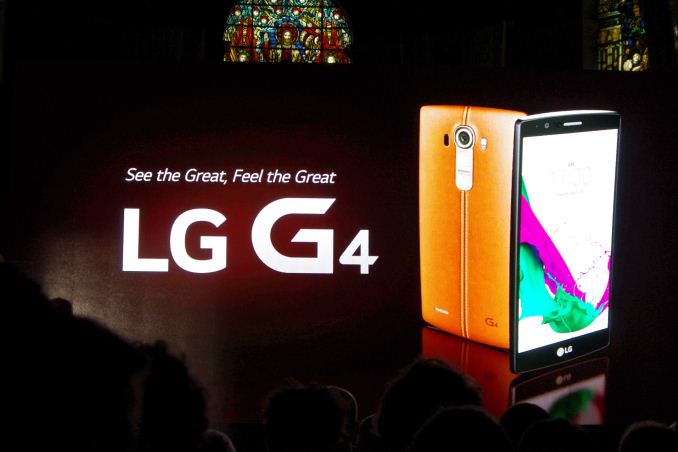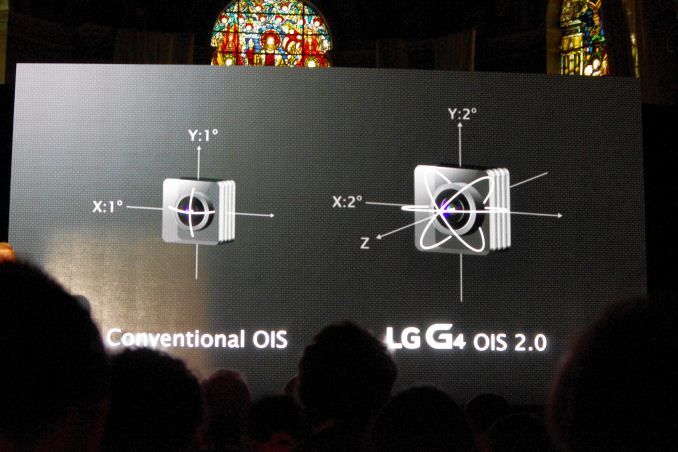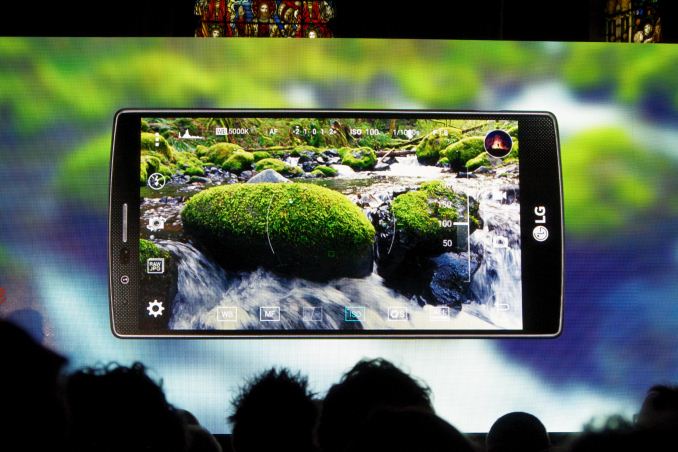LG Announces the G4: 5.5-inch QHD with Snapdragon 808
by Ian Cutress & Andrei Frumusanu on April 28, 2015 11:30 AM EST- Posted in
- Smartphones
- LG
- Mobile
- Snapdragon 808
- LG G4
- MSM8992

In a joint event between London and New York, LG has lifted the veil on the next iteration of its high-end smartphone, the G4. The G3's designs largely borrows from the G3 and iterates on it with a new slightly curved screen and optional leather back covers. The camera seems to be LG's core focus for this device, and we'll get back on those details in just a bit.
The G4 will be the first device to officially use the Snapdragon 808, Qualcomm’s MSM8992 big.LITTLE SoC arrangement that uses two ARM A57 cores in one cluster clocked in at 1.82GHz and four ARM A53s at 1.44GHz in the other. The GPU also uses a lower end Adreno 418 clocked in at 600MHz. Qualcomm avoided LPDDR4 in the S808, and thus remaines a LPDDR3 piece likely running at up to 933MHz.
While we're not too concerned with the resulting CPU performance and loss of two big cores, and slight frequency loss of the Snapdragon 808, it's the GPU which should see higher impact as 3D performance suffers a tad compared to the Snapdragon 810's Adreno 430. In our preliminary tests with the demo device, we see GFXBench Manhattan offscreen go down from 22.7fps to 15fps and T-Rex from 49fps down to 35fps when comparing the G4 to the HTC M9, which sports a FHD screen as opposed ot the QHD one we find in the LG device.
The detailed specification lists shows the iterative improvements over the G3, launched last year:
LG G3 |
LG G4 |
|
| SoC | MSM8974AC Snapdragon 801 4x Krait 400 @ 2.5 GHz |
MSM8992 Snapdragon 808 2xA57 @ 1.82GHz + 4xA53 @ 1.44GHz |
| GPU | Adreno 330 @ 578MHz | Adreno 418 @ 600MHz |
| RAM | 3GB LPDDR3 933MHz | 3GB LPDDR3 933MHz |
| NAND | 32GB NAND (eMMC 5.0) + microSD |
32GB NAND (eMMC 5.0) + microSD |
| Display | 5.5-inch 2560x1440 IPS LCD | 5.5-inch 2560x1440 IPS LCD |
| Network | 2G / 3G / 4G Qualcomm MDM9x25 UE Category 4 LTE |
2G / 3G / 4G Qualcomm X10 (Integrated) UE Category 9 LTE |
| Dimensions | 146.3 x 74.6 x 8.9 mm 149 grams |
148.9 x 76.1 x 6.3 - 9.8 mm 155 grams |
| Camera | 13MP rear camera, 1.12 µm pixels, 1/3.06" CMOS size, F/2.4. 2-axis OIS 2.1MP F/2.0 FFC |
16MP Sony IMX234 rear camera, 1.12µm pixels, 1/2.6" CMOS size F/1.8, 3-axis OIS 8MP Toshiba T4KA3 FFC |
| Battery | 3000 mAh (11.4 Wh) replaceable | 3000 mAh (11.4 Wh) replaceable |
| OS | Android 4.4.2 with LG UI | Android 5.1 with LGUX 4.0 |
| Connectivity | 802.11a/b/g/n/ac + BT 4.0, USB2.0, GPS/GNSS, MHL, DLNA, NFC | 802.11a/b/g/n/ac + BT 4.0 |
| SIM Size | MicroSIM | NanoSIM |
The screen size and resolution stay constant at 5.5" and QHD, but the device has an angular element to it, similar to the LG G Flex 2 but not as pronounced: The screen is touted to be a new generation IPS Quantum display. It looks like LG is claiming 20% gamut increase. The display has 50% increased contrast over the G3, achieving a total of 1500:1 contrast ratio. The G4 reintroduces Panel Self Refresh which was unfortunately missing from the G3, and this should vastly improve battery life over its predecessor.
The screen has a 3000mm radius curve throughout the phone's design that LG markets as "Slim Arc" design.
The phone comes in several different plastic and leather cover options. These are high-quality hand-produced genuine leather products. The plastic version sports a diamond pattern mimicking a metallic look. This also means the G4 is slightly bigger and heavier than the G3 as it comes at a increased 155g. The removable battery of the G4 remains similar to the G3 at 3000 mAh, and the SIM moves to the nano-size. The microSD slot remains an option for the G4.
The G4 gets a camera update, moving from a 13MP to a 16MP design that migrates from an F/2.4 to F/1.8, allowing for potentially better performance. We find a Sony IMX234 sensor, a unit we haven't yet seen used in any other devices. LG were keen to point the F/1.8 over Samsung’s F/1.9 on the latest Galaxy S6. The new OIS system dubbed "OIS 2.0" now offers a 3-axis gyroscope instead of the traditional 2-axis implementations in all current OIS devices. Another first is the implementation of a colour spectrum sensor next to the flash unit, and is able to read RGB and infrared light. LG is able to vastly improve white-balance and also increase clarity for more natural pictures.

The phone now also offers full manual control, with customizable ISO, exposure, shutter speed and white balance among other things. RAW format capture is also supported. Double clicking on the rear buttons already takes a picture within a second, LG is here taking another stab at Samsung's S6 as it only is able to open the camera app in the same time.
The front camera has been boosted to a 8MP Toshiba T4KA3 sensor and sports an improved gesture shot triggering function.
The volume rocker on the rear changes slightly, moving to a flatter central piece. The flash element of the camera in this area is a dual LED design, and we also find the microphone grille at the bottom. One of the elements LG seems to be pushing with the G4 is the design of the back cover, allowing for a replaceable leather rear while retaining the front facia that exhibits a faux carbon-fibre effect of sorts.
The device should be available this week in major markets. We’re currently waiting in line to get some hands-on time with the device, and hopefully on the list to get a sample to follow up from the LG G3 review.












121 Comments
View All Comments
jjj - Tuesday, April 28, 2015 - link
Samsung could sell the 7420 to others so that one could be available first in more phones.SD620 and 618 would be faster single core in theory and those should arrive this year for the mid-range.
Mediatek might have it's rumored dual A72 (2+4+4) this year but likely early next year.
And you can bet that Qualcomm will do all it can to rush SD820 and maybe have it earlier than expected ,their sales are troubled and they need the new chips fast since nobody is happy with the current crop.
It's May in a few days so late this year is not that far away.
I certainly wouldn't consider buying SD810/808 at this time in a high end device.
Maxpower2727 - Tuesday, April 28, 2015 - link
Define "vast majority" in your view. I live in a world where most people don't know even the most rudimentary information regarding the SOC that powers their phone, let alone who made it or how many CPU cores it has.I'm not disagreeing with you regarding the capabilities of the processor, mind you. I just think you need a reality check to understand the extent to which average people outside of your circle actually care.
jjj - Tuesday, April 28, 2015 - link
Your view of how much consumers know and care might be distorted by your location.And do remember that a phone like this is not 200$ , in many markets even carrier subs are more like on T-Mo than VZW or ATT. So it's a much bigger purchase while the number of cores is one of the most visible spec.
In the US clueless ppl will likely go Apple, some Samsung and be done with it.
extide - Tuesday, April 28, 2015 - link
There ALWAYS newer better chips coming...sonicmerlin - Tuesday, April 28, 2015 - link
The DDR3 will also slow down the GPU significantly compared to the competition's DDR4.Vaibhav Sharma - Wednesday, April 29, 2015 - link
Its not that the a57 cores work for more than a few minutes in m9 either way. But i think gflex 2 is better performing than m9. Anyways with the increase in resolution, weaker gpu and plastic instead of metal I think g4 will be even behind m9. Its not that the less cores in g4, gave it a more powerful gpu or higher clocked cores. At best it will match note 4, at worst even the quad core kraits on its last leg will beat it.mczak - Tuesday, April 28, 2015 - link
If you needed even more proof the Snapdragon 810 has thermal / power issues, that would be it. Flagship smartphone model using a lower tier cpu instead.(That said I suspect this is quite a reasonable choice, because neither the A57 cpu cores nor the Adreno 430 could really clock anywhere close to where they should for more than a few seconds in the S810. The S808, having both half the A57 cores and half (?) the shader units in the gpu, should not have the huge throttling issues and hence could end up with nearly the same performance in practice I suspect.)
jjj - Tuesday, April 28, 2015 - link
Many hope for that kind of logic to work but the early benchmarks are not encouraging and in SD810 or 808 usually the bulk of the load is on a single core so i am not counting on 808 performing significantly better. Power consumption might be better.mczak - Tuesday, April 28, 2015 - link
Single thread the performance should just be mostly the same indeed.I'm not saying the 808 will end up faster but just be nearly as fast in practice - hence choosing it instead of the S810 makes technical sense (it should be cheaper after all). Of course, for marketing it's bad (only 6 and not 8 cores!). Compared to what Samsung offers in the S6 this isn't all that great, and compared to the old S801 it's probably not much of an improvement neither, but I'd say it's the best offer (in the higher end space) qualcomm has right now.
jjj - Tuesday, April 28, 2015 - link
805 might be better than 808 and this is LG's flagship that follows the G3, a phone that created a lot of buzz .